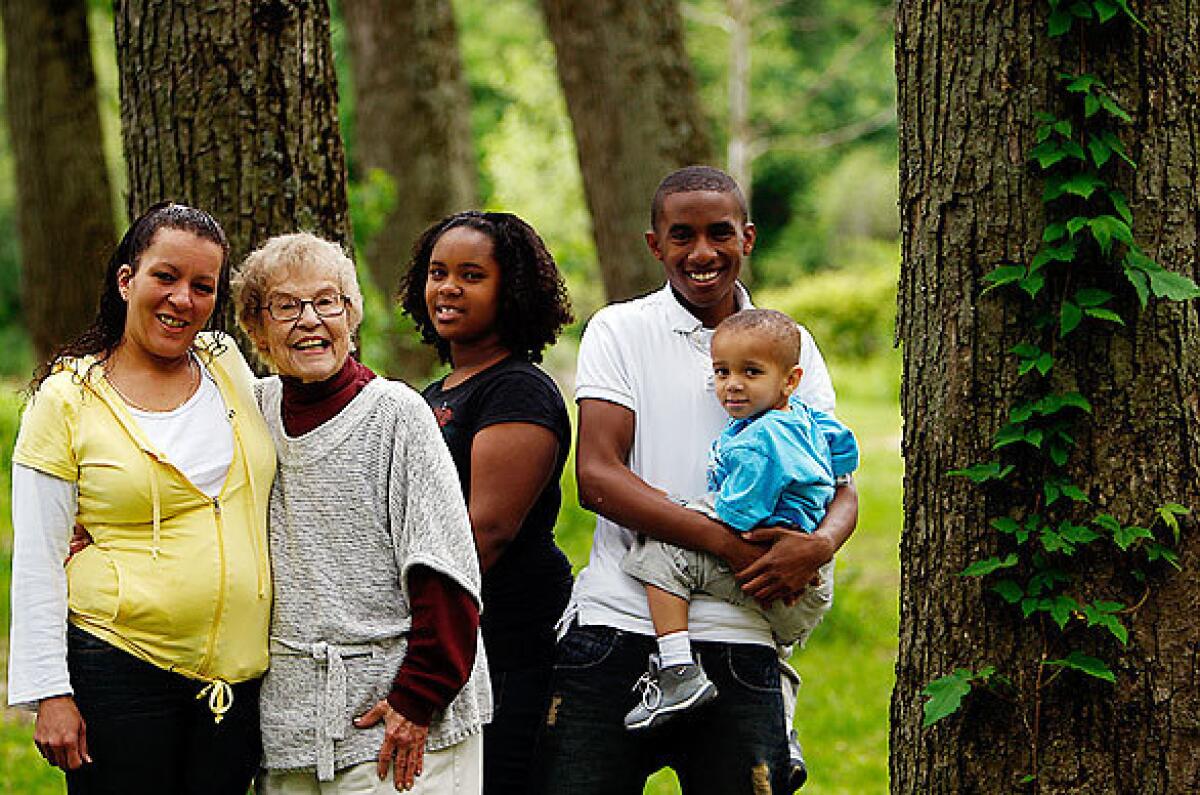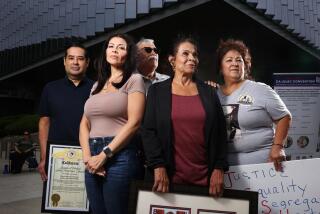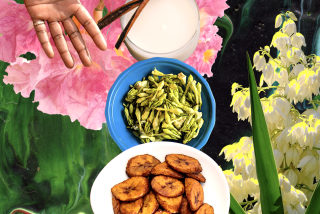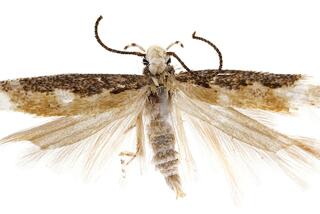An old diary throws him a curve

Reporting from Orange, Va.
On the 19th page of the diary, I saw it.
“Spence Mozingo came to . . . get boards for covering the Tob[acco] house.”
I clasped the back of my head in disbelief.
Francis Taylor, a close cousin of James Madison, had kept a journal of their family’s daily life in Virginia. And there was my great-great-great-great-great-grandfather, picking up lumber on a June day in 1786.
Just seeing the word “Mozingo” in the sphere of the Madisons had the feel of a fantastic anachronism — like seeing my own face among the Founding Fathers on the $2 bill.
I was in Virginia, picking away at the enigma of my family name — thought to be central African and now possessed largely by whites in the South and lower Midwest. I had holed up in old courthouses and libraries, straining to read handwriting so impenetrably florid I found myself cursing town clerks who died two centuries ago. I had met and spoken on the phone with Mozingos whose lack of interest in our origins verged on hostility.
What I knew was this: Every Mozingo in America probably descended from Edward Mozingo, a “Negro man” who lived in the Tidewater region of Virginia in 1644. I could trace myself only as far back as Spencer, who first showed up as a white adult in a 1782 census in the Piedmont, about 80 miles west. Who his parents were, whom he married, where he came from were mysteries.
Fortunately, he had settled in the same small census tract as James Madison.
I had come to the Orange County Historical Society thinking the Francis Taylor journal was a long shot, leaving myself just an hour to get through 500 pages before catching a plane home. Now I skimmed frantically.
“Went down the run to Mozingos to fish . . . caught only two.”
“S. Mozingo came here in Evening & expects his wife to [give birth] soon, Let him have . . . Brandy & 2 lb. bro. Sugar.”
There were notes about Spencer cutting logs, raising a roof, putting up a stable. He was a carpenter like Edward. Trades were often passed down through family lines.
Then I hit an odd entry. On March 23, 1790, “Geo[rge] Taylor sold Mozingo to Hub Taylor for £60.”
What was this? Sold?
It had to be a mistake. The census said Spencer Mozingo was white.
Then this: “Mozingo (whom G Taylor sold Hd Taylor) set off down to his new master.”
My great-great-great-great-great-grandfather was a slave?
I could grasp having a black ancestor way back in the 1600s. But in the 1800s? A slave? Spencer died in the 1830s, just 80 years before my grandfather was born.
Were his descendants slaves at the outset of the Civil War? How would we have kept our name? Wouldn’t we all be Taylors? This was unfathomable.
But the diary seemed so clear. Mozingo. Sold. Master.
What would my family think?
My wife, Noaki, who was mixed-race — Irish and German on one side and Japanese on the other — surely would be fascinated.
I wasn’t as certain about my parents.
They could laugh off a blood connection to the black Edward Mozingo because it was so far back and we could not trace ourselves directly to him. But there was no escape here. My dad, whose skin sears pink in an hour at the beach, may have descended from a slave.
When I told him about the diary, he gave me a mildly intrigued “Hmmm.”
My mom was equally inscrutable, never seeming fully convinced of my research, always floating an afterthought. “I wonder why on Google I found a Pietro Mozingo in Italy.”
My parents have always been fairly liberal in accepting other people’s differences. But recognizing the other as an element of ourselves was harder, especially since our names are so entwined with our identities.
And there’s little doubt our name came from Edward.
“We’re sure he came from Kongo,” said Linda Heywood, a historian who studies the language and history of central Africa and its diaspora.
Until it disappeared in 1914, the Kingdom of Kongo ruled the Atlantic coast and tablelands around the modern-day border of Angola and the Democratic Republic of Congo. Its people spoke Kikongo, a Bantu language.
Their enemies, their outcasts, their perceived traitors and competitors became America’s first slaves.
At the time of Edward’s birth, the kingdom was the most powerful and Westernized in central Africa, with Jesuit colleges and an ambassador to the Vatican. The kings were Mozingos.
Heywood and her husband, John Thornton, both history professors at Boston University, say the name was common back then, pronounced something like Mosinga or Muzinga and spelled a variety of ways. He e-mailed me a copy of a 16th century Portuguese text that mentioned a King “Amosinga.”
They suspect that Edward Mozingo — or his father, if Edward was born in Virginia — was a lower nobleman and warrior caught up in the kingdom’s political intrigue, then sold.
It was rare for an African to insist on keeping his own name in the New World. Most were listed on arrival by a Portuguese or Spanish first name, followed by the word “Negro” or the country of origin.
“Because the name ‘Mozingo’ is not an ‘Angola’ or ‘Kongo’ or ‘Negro,’ but is an actual personal name, suggests to us he was a noble and literate,” Heywood said.
“You and all the other Mozingos are fortunate that he was literate and kept his name.”
We may have been fortunate, but as a whole we weren’t particularly grateful.
Tom Mozingo, 68 and retired to central Florida, is the elder statesman of Mozingo genealogy. He braces relatives who ask him about the name. “If I tell you the truth, can you handle it?” he asks them. “Can your family handle it?”
Tom was in the Navy in the 1970s when he first got an inkling of the African origins. At a conference of naval attaches in San Diego, a “giant black man” with a Cameroonian patch on his uniform noticed Tom’s name tag.
“Oh, we have people with that name in my country,” the man said.
“A lot of people?” Tom asked.
“Many, many people.”
By the 1990s, Tom was producing a family genealogy newsletter. He had traced his ancestry to Edward and come to accept him, with some pride, as his forebear.
“Hey, I descended from an African prince,” he said.
But he wouldn’t mention him in the newsletter. Tom didn’t want to upset his subscribers, many of them older and not about to change their beliefs.
One descendant who knew about Edward had begged Tom not to write about him. “He had two daughters who were of marrying age, and he didn’t want them embarrassed,” Tom said. “It made it very personal for me to have a father ask that.”
I understood, but I didn’t agree about keeping quiet.
The charade had gone on for 300 years. In the past, it may have been a measure of self-preservation. What were we suppressing the truth for now? To protect feelings that should have been obsolete long ago?
With DNA technology and websites like ancestry.com, people are delving into their roots like never before, and both white and black often find a more complex racial history than they’d imagined.
But in our case, denial allows fairy tales to flourish.
Online Mozingo chat groups are filled with comments like this: “My carpet cleaner told me the name was Italian. He said he had lived in Northern Italy and ‘Mozingo’ was a very common name.”
Every Mozingo family in America seems to have nurtured a different source for the name: Italian, Portuguese, French Huguenot, Basque, Spanish, Cajun, Black Irish, Native American, English.
Were any true? The Italian white pages online showed “nessun resulto” — no result — for Mozingo or anything like it. An Italian linguist at UCLA and a Italian-language professor at Yale whom I consulted said they’d never heard the name, as did a Portuguese professor at Brown and an expert on French Huguenots at the Universite de Toulouse, France.
The name could be found in one place outside of America: west central Africa. There is a town called Mazingo in Gabon. And Zaire’s basketball coach in the 1996 Summer Olympics in Atlanta was Monga Maluku Mozingo. When I called him in Kinshasa, he said there were many Mozingos in his father’s hometown on the Congo River.
There was also a mysterious “Col. Robert Mozingo” who showed up on a list of deaths in Newtown, Conn., in 1801. Though black decedents on the list were noted as “Negro,” the colonel was called “an African.”
This issue should have been settled years ago with the Mozingo DNA project. But unlike many family DNA projects, its founders, including Tom, promised total confidentiality and have guarded the results.
Word of central Africa has trickled out in Web forums, but never with the imprimatur to close the case.
It’s assuredly not our European heritage they’re trying to keep under wraps.
After my trip to Virginia, I was planning to go to Indiana to meet other descendants of Spencer at a family reunion.
Many of them settled south of Greensburg, a city of 10,260 people, of whom eight are black, according to the 2000 U.S. Census. A recent mayor there drew complaints when he was quoted in the newspaper using the term “colored people.”
I had to find out if Spencer was really a slave. What a grenade this could be to lob into the reunion.
Ann Miller, a dogged Virginia historian who has helped me immensely, unearthed the answer.
A 1782 tax list described Spencer Mozingo as the head of his household, not a slave. In that same list, the Taylor family’s “taxables” included a slave named Mozingo.
The diary I had read sometimes said “Spence Mozingo” and other times just “Mozingo,” who did indeed seem like a slave in notations like this: “Mozingo says a Mad Cow died today, & if it should be skinned wch. I directed to be done.”
They apparently were different people.
“Pretty amazing that you have two individuals named Mozingo, both with some sort of association with the Taylor family — what are the odds?” Miller said.
The name was too rare in America for this to be a coincidence; fewer than 30 people had it when Spencer was born. Maybe he and the slave Mozingo were cousins or half-brothers. Maybe the slave was Spencer’s son by a female slave. Maybe Taylor named his slave after Spencer.
Sometimes you wish you could ask the dead a few questions.
Spencer, his six children and their spouses trekked from Virginia to Kentucky around 1805. His sons bought land surveyed by Daniel Boone on Raven Creek, in Harrison County. Spencer died there in poverty in 1831.
Before the reunion in Indiana, I spent a few days in Kentucky, looking at yellowed records and lichen-spotted tombstones, feeling how transient our turn on this planet is. I couldn’t even find a grave for Spencer.
One afternoon, I sat under the hickories and alders on Raven Creek, smoking a gas-station cigar, looking at the polliwogs, listening to the warblers and larks.
This was the knowable beginning. I didn’t know exactly where Spencer had lived in Virginia, didn’t know how he was connected to Edward, the Bantu warrior. But he had been here, likely watching this water drifting by on a spring afternoon.
The year after Spencer died, his grandson, Henry, set out west. In the rocky frontier of Decatur County, Ind., where the government had just removed the last Indians, Henry built a log cabin next to a creek, cleared timber and went back to Kentucky for his family.
His mother, father and his younger brother (my great-great-great-grandfather Joe) made the journey with him and settled near his cabin. Henry’s descendants stayed put, multiplying fast, with as many as 15 children per couple.
They live all over Decatur County, a close but fractious clan.
“I am the patriarch,” Marlon “Bud” Mozingo, 74, my fourth cousin once removed, declared on a warm night at his ranch southeast of Greensburg.
“You’re not the patriarch — Dale is,” rasped his 78-year-old first cousin, Amy Osting, also my fourth cousin once removed.
Their cigarette smoke swirled around them.
“I’m the patriarch,” he said, more forcefully.
“Oh, piss,” Amy said.
I had been warned that Bud was “colorful.”
Driving up, I noticed shoes nailed to every fence post along the road. At the house, Bud was sitting alone on the deck in his shorts and socks, ignoring his wife Shirley’s complaints that she had just sealed the wood. He looked grumpy and stubborn, with a big lumpy head like Jerry Lewis’.
I would learn this was his regular demeanor, a volatile mix of facetious, cranky, sentimental and generous that made it hard to gauge his true opinions. He offered me a Bud Light, and we got to talking about his beffalo.
“You take a buffalo and breed them to a bull, you get beefalo,” he said.
Bud was a horse trader who, I was told, could sell sand in a desert. Beefalo was his newest venture. The shoes were an earlier one.
He and his brother Stan once bought a load of shoes for a dollar at an auction. When they got home, they found there were no pairs. So they nailed them to the fence, one by one.
We walked to the little lake behind his house. Bud was broad-shouldered and built like a whiskey barrel. He threw some food pellets to his giant catfish, which gulped slowly with disturbingly human-like lips.
“You know what a Dutchman is?” Bud asked.
“Not really.”
“I don’t like Dutchmen,” he said.
He cocked his head to look at me. “I don’t like queers, I don’t like niggers.”
“Don’t use that word!” Amy barked.
“That’s the word I used since I was a little boy,” he replied.
“You like Tanya?” Amy asked.
“She’s not one,” he said, looking slightly hurt. “It doesn’t have to do with color. You can be white and be one.”
Amy told him he was full of it (if “it” had two more letters).
I asked where they thought the name Mozingo came from.
“It’s an English name, I think,” Shirley said, turning to Bud. “When Orville went to England, he looked it up. He saw cemeteries over there and Mozingo stones in the cemeteries.”
Bud changed the subject.
“You notice anything you don’t notice in other towns?” Bud asked. “There’s no coloreds.”
“They hung one of them way back and they left,” Shirley said in a matter-of-fact tone — no hint of endorsement.
“They don’t let them come back after sunset,” Bud said.
The part about black people leaving was true. In 1880, there were 235 in town. In 1960, there were three.
I met Amy the next morning at her house, set off the dirt road in a stand of maple and shag-bark hickory.
Amy was short and thin, with graying red hair and sharp dark eyes. She was a rural mail carrier for 23 years and a true eccentric. She listened to a police scanner in the kitchen, fed raccoons on her porch, spoke nearly every word she ever thought, cussed a good deal of them and laughed until she started hacking.
She lived alone — her husband died eight years ago — with a poodle named Jake and so many cats my nose was grateful when she lit up a smoke.
She pulled out two photos for me. The first showed her filling a giant beige bra before she had a double mastectomy a few years back. She laughed. The other was of her granddaughter Tanya.
In 1973, Amy’s daughter, Beth, was a 16-year-old dropout and alcoholic who ran away from home to live in near-squalor with her older sister Lynn in Florida.
Beth called home one day to say she was pregnant and that Lynn’s two kids were hungry.
Amy and family headed down Interstate 75. When they approached the house, her sister Carol noticed that they were in the “black section” of town. They saw Beth and Lynn in a backyard and a little black boy playing. Carol pointed to Beth’s belly and said, “Is that ni-gro too?”
Beth nodded. Three weeks later, Beth was back home and refusing Amy’s order to get an abortion. While Amy never shared or understood her neighbors’ antipathy toward black people, this was as taboo as it got in Greensburg.
Beth named her baby girl Tanya (the first syllable rhyming with “man”) because she had a tan.
Amy and her late husband Maury fell in love with the baby. She still chokes up talking about it and calls Tanya her “greatest blessing.”
Amy and Maury ended up raising her in Indiana. She was the only black child in school, and Amy protected her with a vengeance. The family — Bud included — embraced her.
Tanya, now 36 and a single mother of three, lives in nearby Columbus, Ind. She recently quit her job at a Toyota parts plant to go into nursing, and is working at a nursing home.
“My grandparents spoiled me,” Tanya would tell me later. “Had they not been there for me, my life would have gone in a totally different direction.”
I told Amy about Edward Mozingo and showed her the colonial court’s description of him as a “Negro man.” She was delighted and wanted a copy to needle Bud with. “I’m so happy for Tanya,” she said, tearing up.
After leaving her house, I met Bud and his brother Stan to go look for Mozingo graves.
Stan was a thin 67-year-old fence builder with pale blue eyes, jug-handle ears and two missing front teeth blown out by the flying metal hook of a come-along winch. He lived deep in the country and broke mules. He was impeccably polite, with the Southern courtesy of saying your name in almost every sentence. But he exuded a much more potent venom than Bud toward black people.
I asked him why. He said he hated only the ones he called “niggers.”
“I have colored friends,” he said. “A colored man, Jack Strode, taught me more than anyone else I know about breaking mules.”
Bud’s and Stan’s bigotry wasn’t inflexible: If they were thrust into a situation with a black person and got a decent impression, that person would be exempted from their rancor.
I was about to let the issue go when Bud mentioned the Ku Klux Klan.
“Were Mozingos in the Klan?” I asked.
“Oh, heavens, yes,” he said. “Grandpa Joe was a Klan member. Edwin was a Klan member.”
They must have been the only Bantu white supremacists in the United States.
During our drive and in later conversations, I tried to talk to Stan about the name Mozingo. Had he wondered about it? “It doesn’t sound like Brown or Smith or Jones,” I said.
“Yeah, but it doesn’t sound like Obama, either, heh-heh-heh,” he said.
Would he have a problem if it was African?
“No, it wouldn’t be no problem, Joe, nuh-uh. No, it wouldn’t be no problem. Because the way I look at it, God made all us people. And you know, we just know it’s not African, Joe.”
“You know it’s not African?” I asked
“It’s not African, no. The first I heard is from Hungary, Northern Italy, somewhere like that.”
I told him about Edward being black, about the generations of mixing that made us white.
“OK, it’s not African, Joe. I ain’t never seen a colored Mozingo. . . . Back when they brought the Africans over here, they had a first name but no last name. And the Mozingos used to own slaves, and they took their masters’ name.”
Now I let it go.
There were a few highlights to the reunion that afternoon, besides meeting dozens of people who welcomed me with a hospitality I didn’t think existed anymore. A woman with a striking resemblance to Benjamin Franklin besieged me with dubious family gossip. Bud irked his wife by walking around with his blue briefs pulled halfway up his belly. I met his favorite granddaughter, a social worker who worked with minority kids. Tanya arrived with her three children, and Amy set out big photos of them on the mantel.
Why was it so hard for us to accept that white people could descend from a black man, after many generations of mixing, when we accept the opposite without a thought? Here was a white line of people turning black, by their definition, in a single generation with Tanya.
Stan showed me a printout titled “Historiography” of Mozingo. “The surname Mozingo . . .is believed to be associated with the Spaniards, meaning ‘one who was young in appearance.’ ”
There was another printout on the mantel, “The Surname History of the Family,” that said, “The Italian surname MOZINGO was from the English given name, James . . .”
I watched everyone talking and laughing and griping, the children playing outside, throwing water balloons at a grinning Bud, and thought this was Spencer’s epitaph, for better or worse.
joe.mozingo@latimes.com
Next: The racial divide.
More to Read
Sign up for Essential California
The most important California stories and recommendations in your inbox every morning.
You may occasionally receive promotional content from the Los Angeles Times.











